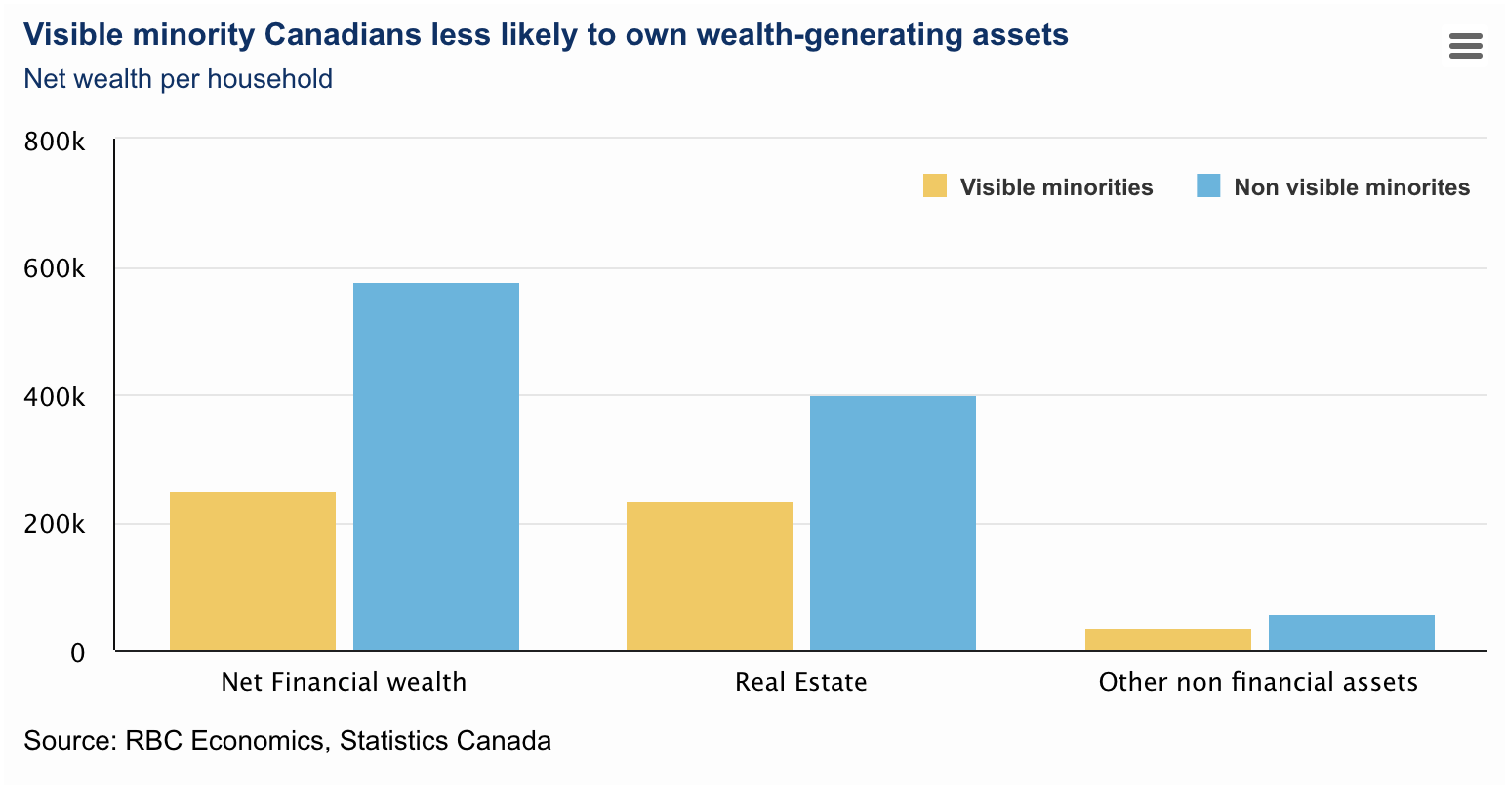The Insights
- Net wealth gains have not been distributed equally during the pandemic, particularly among visible minority groups already at a disadvantage heading into the crisis.
- Visible minorities have benefitted less from a record surge in household wealth, in part because they are less likely to own homes, businesses and wealth-generating vehicles.
- Had visible minorities owned homes at similar rate to white Canadians during the pandemic, their collective net wealth would be $100B higher.
- Boosting business ownership and encouraging better outcomes for visible minorities could help pave the way for more innovation and enhance Canada’s global competitiveness.
- Visible minority Canadians less likely to own wealth-generating assets

The Context
Canadians amassed record savings and wealth during the pandemic. But for Canadians of colour, the gains have been less substantial. This isn’t a new issue. For decades, visible minorities have had fewer vehicles with which to build wealth. They are less likely to own financial assets or businesses. And critically, they are less likely to own homes. This should not come as a huge surprise given that they earn as little as ~ 85 cents per dollar compared to the non-visible minority population, often despite having more formal education.
As the government winds down emergency/pandemic supports, longstanding income and wealth gaps are set to resurface.

Our Analysis
Home equity accounts for almost 40% of total national household net worth. It also represented the largest source of wealth appreciation during the pandemic, accounting for 55% of a total $2.8 trillion increase in household wealth gains since Q4/2019. But a lower rate of home ownership has left many Canadians of colour on the outside looking in. Had visible minorities owned homes at a similar rate to white Canadians their collective net wealth would be $100B higher. What’s more, visible minorities earn less from wages and investment income—as little as 65 cents per investment dollar compared to the non-visible minority population. Visible minorities suffered disproportional job losses in 2020. Recent survey data showed that despite an improving labour market, their unemployment rate remained 1.8 percentage points above their peer group in Dec 2021—a legacy that predates COVID.

Higher net wealth improves financing and education opportunities. It also makes re-skilling easier and helps individuals weather periods of unemployment or loss of income. And research has shown a lack of accumulated household wealth to be a key obstacle for business development, particularly in the startup phase when financing is hard to secure and owners rely more heavily on personal and/or family savings.

Against that background, it’s less surprising that fewer visible minorities are business owners. In Canada, this group represents a fifth of the population but just 13% of private business owners. Breaking this pattern would benefit the economy as a whole. For instance, if visible minorities owned businesses at a rate comparable to the overall population, more than 100,000 new businesses would be created, each with the potential to hire between 8 and 10 workers.
A larger share of businesses owned by visible minority Canadians (more than 70%) reported lower revenues due to the pandemic compared to non-visible minority owned businesses. Timely government supports have helped cushion the blow, but are slated to wind down. And financing gaps remain, with more than 15% of visible-minority-owned businesses struggling to access funding—nearly double the rate for businesses overall. With financing already a challenge prior to the pandemic, there is a concern that many of these businesses won’t have a soft landing as they contend with rising input costs and labour shortages.

The Road Ahead
The long-run macroeconomic benefits of addressing wealth inequality and encouraging visible minority entrepreneurship are sizeable. A Statistics Canada survey showed that visible minority businesses owners were more likely to innovate, enhancing Canada’s global competitiveness. And leading innovative businesses have been shown to grow at a rate 16% above the least innovative, delivering additional revenue of $250 million over three years. Empowering talented Canadians from visible minority groups with more opportunity can help to narrow long-standing wealth gaps, while fostering positive long-run productivity impacts.
